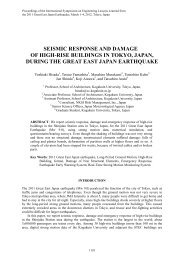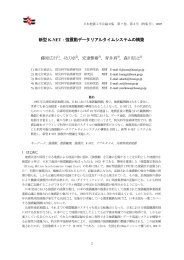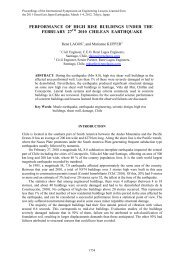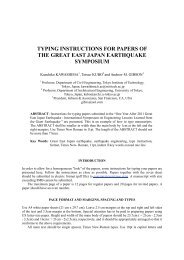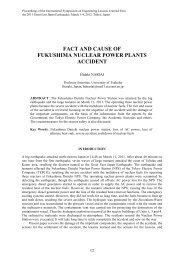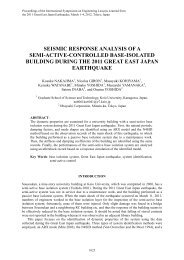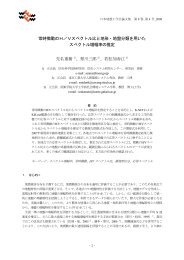Application of Seamless Simulation of Seismic Response Analysis ...
Application of Seamless Simulation of Seismic Response Analysis ...
Application of Seamless Simulation of Seismic Response Analysis ...
- No tags were found...
Create successful ePaper yourself
Turn your PDF publications into a flip-book with our unique Google optimized e-Paper software.
Fig. 3 Constructed CCM, consisting <strong>of</strong> external shape <strong>of</strong> structures and ground elevation. GIS dataprovided by Geospatial Information Authority <strong>of</strong> Japan and NTT Geospace Corporation is used.Fig. 4 Results <strong>of</strong> SRA at t = 91.0s from start <strong>of</strong> simulation. Colors indicate magnitude <strong>of</strong> deformation.<strong>Response</strong> <strong>of</strong> each structure under SGM observed in the 2011 Tohoku region earthquake is analyzed.input the same SGM to the base <strong>of</strong> each structure. The simulation is 0.01s x 30,000steps = 300s. Fig. 4shows snapshots at t = 91.0s after start <strong>of</strong> the simulation. From this figure we can see that structureshave different response to the same input SGM according to its height, shape, and directions.We deform structures by assuming that a structure will collapse if the maximum deformation angledefined in Eq. (1) is larger than a threshold R 0 = 1/40. We set this threshold relatively small comparedto the real estimate for a structure to collapse so that a number <strong>of</strong> structures will collapse; we do this tohave a clear difference between the modified and original city models. Fig. 5 shows the deformed state<strong>of</strong> the city, where blue indicates collapsed shape, transparent indicates original shape, and solid whiteindicate shapes <strong>of</strong> structures that are not determined to be collapsed.Two cases <strong>of</strong> HRTS are performed; case 1 is with the modification <strong>of</strong> structures based on SRA,and case 2 is the original CCM without modifications. We conduct HRTS on a 1,000 x 800m area,each discretized in resolution <strong>of</strong> 1m. We input tsunami wave using a block <strong>of</strong> water 12m in height withinitial velocity <strong>of</strong> 5m/s; see Fig. 6. Although this setting is quite different from the actual tsunami wavethat hit this area, it is enough to confirm that the HRTS is applicable to a real city dataset stored in GIS.We plan to use computed tsunami waves from the source to bay area as input tsunami waves in thefuture. The number <strong>of</strong> boundary particles used to model elevation and structure shapes for the 2 cases543




